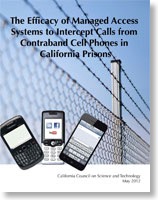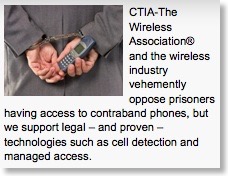California Report on Prison Cell Phone Use Issues
As of July 2008, seventy-six members and fellows are also members of the National Academies, six are Nobel laureates, nine are National Medal of Science recipients and two are recipients of the National Medal of Technology.
CTIA and the major cellular carriers believe that Section 333 of the Communications Act precludes FCC from authorizing jamming of cellular communications by private sector or state or local government officials. The meaning of Section 333 has been a recurring topic here. While NTIA appears to agree with the cellular industry in this interoperation of the section, it appears that FCC has never made an en banc finding on this interpretation of the law although it is clear that under present FCC rules jamming is not authorized.
The CCST report describes managed access as:
“The Managed Access System (MAS) refers to a standard cell phone network system used in a defined close quarter geographic area such as a campus, military base or a prison. The theory behind MAS is to allow authorized cell phones to connect to the standard carrier (e.g. AT&T, Sprint, T-Mobile,Verizon) networks, while preventing unauthorized cell phones from connecting to the carrier networks. A well-designed and implemented MAS would function as a system to detect and preclude the operation of cell phones not authorized in the MAS approved database.”
CTIA and NTIA both feel that “managed access” is an effective technology for controlling cell phone use in prisons and the resulting threat to public safety. The CTIA website has the quote shown at left clearly describes managed access as “proven technology”. However, the December 2010 NTIA repot mandated by Congress does not go as far as CTIA does in saying that managed access is “proven”. NTIA merely states that “Managed access technologies hold promise as a solution” (p. 37) and that “(t)he technology requires close coordination with the FCC and wireless carriers”. NTIA also raised questions about the cost of managed access.
In contrast to CTIA’s confidence in managed access and NTIA’s optimism, CCST finds
“(T)he Managed Access System (MAS) technology of today is not mature enough for immediate large-scale deployments such as that proposed by CDCR at California’s 33 state prisons.”(p.6)
Readers who followed the Linkedin Spectrum Experts group discussion on the NTIA report may recall that Australia’s Barry Matson suggested the solution may be putting the burden on the cell operators to not connect calls from cell phones in prisons. The report independently comes to a similar suggestion:
The CCST Project Team recommends that potentially useful technology approaches be explored in confined prison areas, and that cell phone carriers be engaged to explore options of denying connections for ‘unregistered’ cell phones within prison locations using the carriers’ technology. In this latter case, identity of illegal cellular phones could be obtained via a benchmarking technology and the carrier could then deny cellular connection to the specific unregistered devices. Engaging the carriers would likely require either a legal requirement to participate or an income incentive via fee for participation. With the recent agreement of cell phone carriers with the federal government to disable services on stolen cell phones, this approach should be explored.
But even if managed access is ever to be used on a large scale it needs a better policy foundation than FCC just condoning its use. Successful managed access requires both the active participation of all the cellular carriers near a prison and detailed coordination of any technical changes to the cellular network including introduction of changes in the physical layer of the RF signal as well as new services. A successfully operating managed access system can become useless overnight and endanger public safety if one of the cellular systems in the area has an unanticipated technical change. While the major cellular carriers have indicated a willingness to accept managed access systems and sign agreements with prison authorities, they have never stated that would coordinate all technical changes and delay them as necessary until the managed access systems were upgraded. In addition, the 4 major cellular carriers are not the only carriers in the country, especially int he rural areas where maximum security prisons are often located. Indeed, future cellular auctions could well result in more corporate diversity. CCST finds
“A coordinated effort of several states to petition the FCC to modify existing spectrum owners’ agreements to require they provide unobstructed use of their spectrum within the geospatial confines of corrections facilities would be an important modification of regulations. If this effort is undertaken, the discussions could also include the possibility of using jamming technologies in some conditions.”
While the mainstream cellular industry is enthusiastic about managed access because it may allow jamming to be kept in Pandora’s Box, they have never taken a more positive step to build the policy infrastructure needed to give managed access a fair chance of success, whether or not that is really possible in the technical sense.





![Validate my RSS feed [Valid RSS]](valid-rss-rogers.png)

